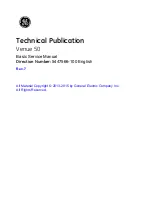
Operating Instructions
61
Appendix C: Test Technique and Sequence
Test Technique
As with any other OAE or Tympanometry instrument, there is a technique to learn when using the
ERO•SCAN Pro instrument, especially for
infants and young children. Experience with existing systems
suggests that it may take up to 3 months to become completely proficient at selecting the proper eartip
and positioning the probe.
When testing an infant, the following suggestions might be helpful: The infant has to be relatively quiet
and calm; it is usually preferred for the infant to be asleep. A pacifier may be used to calm the infant;
however, sucking will add noise to the test and decrease the likelihood of a passing result. When
testing an infant, gently pull down and back on the pinna to straighten out the ear canal. Generally the
external probe is preferred for testing newborns. Position the probe pre-amp enclosure so that there is
no weight on the probe cable and it is directed away from the infant's hands. Place the probe in the
ear canal and, if necessary, wait for the infant to calm before beginning the test. Swaddling the infant
in a blanket can help prevent him/her from moving and pulling the probe out of the ear during testing.
When testing a young child, the following suggestions might be helpful: The child has to be relatively
quiet and calm. Quiet distracting toys should be used to distract the child during testing. Ideally these
toys are something the child can hold during testing. This will keep his/her hands occupied preventing
the child from pulling the probe out of the ear. Generally, the external probe is preferred for testing
young children. Secure the probe to the patient using the lanyard neckloop or the clip being sure to
keep any weight off the probe cable. Although it is a matter of preference, many users prefer to start
the test prior to inserting the probe in the ear. This allows the tester to focus on the patient.
Test Sequence
A complete test sequence consists of an AutoStart, calibration and test phase. The AutoStart phase
determines when the calibration and test phase should proceed, while the calibration phase calibrates
the level of the tones that will be applied during the actual test phase. Artifact rejection is employed
during the test phase to reduce the effect of transient noise bursts.
Immediately after the test button is pressed, the AutoStart phase of the test begins. Autostart checks
both the quality and stability of the seal by measuring the response obtained from a sequence of test
tones. The stability of the seal is determined by comparing the responses obtained over time. When the
level of the response is within an acceptable range and is stable over time, the unit proceeds to the
calibration and test phase.
DPOAE
The calibration phase automatically measures the response obtained from a calibration tone that is
present prior to each set of test tones and calculates the voltage needed to obtain the desired pressures.
If one or more of the desired pressures cannot be obtained, the instrument continues with
measurement, but will display an error message at completion of the test if appropriate.
The test phase consists of measuring the response obtained from the pairs of test frequencies (f
1
, f
2
)
applied to the receivers. Two receivers are used, with each receiver generating one frequency in order to
reduce intermodulation distortion. Frequency domain estimates of the actual P1, P2, distortion (DP) and
noise floor (NF) are obtained via the discrete Fourier Transform, with a bin resolution of approximately
31 Hz. The NF estimate is obtained by averaging the power in the 4 closest (+/-2) bins to the DP bin.
Содержание Ero Scan Pro
Страница 74: ...1162 0802 Rev E 05 12...











































